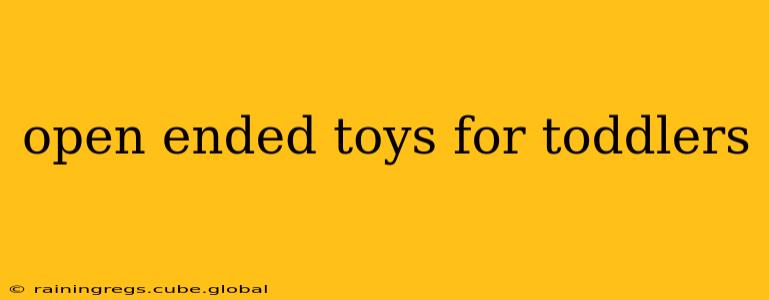Open-ended toys are a parent's best friend. Unlike toys with a single, prescribed function, open-ended toys offer a world of possibilities, encouraging creativity, problem-solving, and imaginative play. These toys are versatile and adaptable, allowing toddlers to use them in countless ways, limited only by their imaginations. This means longer playtime and a richer learning experience. But what exactly are open-ended toys, and what are some great examples for toddlers? Let's dive in!
What are Open-Ended Toys?
Open-ended toys are designed to be flexible and adaptable. They don't come with specific instructions or a single "right" way to play. Instead, they inspire children to use their creativity and problem-solving skills to explore, experiment, and create their own games and stories. This fosters independence, encourages self-expression, and allows children to learn at their own pace.
Why Choose Open-Ended Toys for Toddlers?
The benefits of open-ended toys for toddlers are numerous:
- Boost Creativity and Imagination: The lack of prescribed play allows children to develop their own narratives and scenarios.
- Develop Fine Motor Skills: Many open-ended toys, such as blocks and stacking toys, help refine dexterity and hand-eye coordination.
- Enhance Problem-Solving Skills: Figuring out how to build a tower, fit shapes together, or create a scene encourages critical thinking.
- Promote Social Interaction: Many open-ended toys can be used collaboratively, fostering teamwork and communication skills.
- Encourage Independent Play: These toys empower toddlers to engage in self-directed play, building confidence and independence.
- Last Longer: Because they can be used in multiple ways, open-ended toys often last longer than those with a single function.
What are some examples of open-ended toys for toddlers?
Here are some excellent open-ended toy ideas for toddlers, categorized for easier browsing:
Building & Construction Toys
- Wooden Blocks: Classic and timeless, wooden blocks offer endless possibilities for building towers, castles, roads, and more. Consider various shapes and sizes for added complexity.
- Large LEGO Duplo Bricks: These oversized bricks are perfect for little hands and allow for creative construction.
- Building Sets with Unstructured Pieces: Look for sets that don't prescribe a specific model, encouraging free-form building.
Creative & Imaginative Play
- Play Silks: Lightweight and colorful, these fabrics can be draped, folded, and used to create forts, costumes, or imaginative landscapes.
- Dress-Up Clothes: Old clothes, hats, and scarves provide endless opportunities for role-playing and imaginative play.
- Dolls and Soft Toys: Simple dolls and soft toys with minimal features can spark imaginative storytelling and nurturing play.
Sensory & Manipulative Toys
- Balls: Simple balls in various sizes and textures encourage throwing, catching, and rolling, promoting gross motor skills.
- Fabric Scrap Bags: Fill a bag with various fabric scraps of different textures and colors for sensory exploration.
- Stacking Cups or Rings: These help develop fine motor skills and hand-eye coordination.
Art & Craft Supplies
- Crayons, Markers, and Paper: Simple art supplies allow toddlers to express themselves creatively.
- Play Dough: Play dough encourages tactile exploration and fine motor skill development.
- Finger Paints: Non-toxic finger paints provide a fun and messy sensory experience.
H2: What age are open-ended toys suitable for?
Open-ended toys are suitable for a wide range of ages, including toddlers. However, it's crucial to select toys appropriate for the child's developmental stage. Toddlers typically benefit most from larger, simpler toys with few small parts that pose a choking hazard. Always supervise young children during playtime.
H2: Are open-ended toys more expensive than other toys?
Not necessarily. While some high-quality wooden toys can be more expensive, many excellent open-ended toys are available at affordable prices. Consider looking for used toys or making some yourself from recycled materials.
H2: How can I encourage my toddler to play with open-ended toys?
Sometimes, toddlers need a little guidance to explore the possibilities of open-ended toys. Join in the play, suggest ideas, and let your child lead the way. Avoid directing the play too much; instead, offer suggestions and encouragement. Demonstrate how to use the toys in different ways and let your child's creativity shine!
By providing your toddler with open-ended toys, you're not just giving them a toy; you're giving them the gift of imagination, creativity, and lifelong learning. So, ditch the single-function toys and embrace the endless possibilities of open-ended play!
